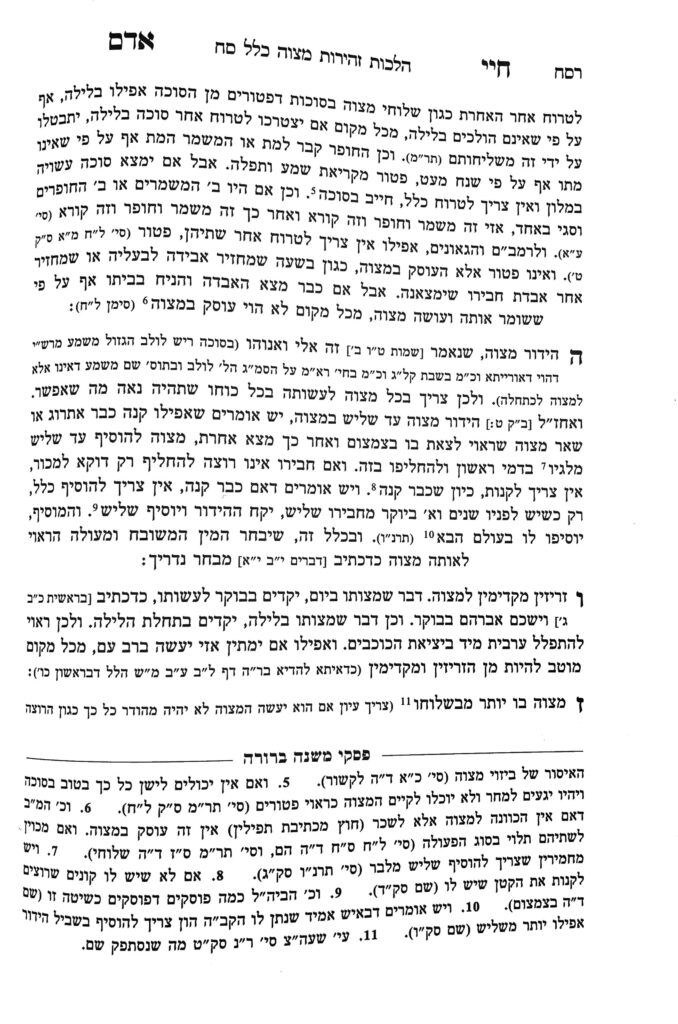We are continuing in siman 4, discussing the concept of oseik bmitzvah patur min hamitzvah. We left off with a question regarding the reason the Torah teaches the concept of oseik bmitzvah patur min hamitzvah twice. We learned that according to the Ran, the second pasuk comes to teach that even when a person is able to do the second mitzvah (efshar lekayeim shneyhem), they are still patur. However, Tosfos holds that when efshar lekayeim shneyhem, they are not patur and must perform both. So the case that is patur must be a case when it is not possible to do both. It would be logical to keep doing the mitzvah that you already started, so seemingly, there is no need for a pasuk. If so, we need to clarify the position of Tosfos and how he understands the need for a limud to teach us oseik bmitzvah patur min hamitzvah.
To take the question a step further, we have learned about the concept of ain ma’avirin al hamitzvos, that if one is presented with the opportunity to perform two mitzvos, and comes upon one of them first, he is not allowed to ignore that mitzvah in order to perform the other. One may not leave the mitzvah already in front of them in order to perform another mitzvah, even if they plan to return to the first mitzvah later. Similarly, we can assume that once one has already begun a mitzvah, they should not leave one mitzvah to perform another one. If so, the concept of oseik bmitzvah patur min hamitzvah can be learned from ain ma’avirin, and does not even need its own pasuk.
The Ritvah in maseches Sukkah discusses this question and gives two answers. His first answer is that one may have thought that when they encounter such a situation (i.e., they are currently engaged in a mitzvah and another mitzvah comes their way), they would have the option to choose one or the other. His second answer is that one may have thought that if the second mitzvah is a mitzvah overes (a mitzvah which can only be fulfilled for a limited amount of tim) they should stop their current mitzvah and perform the mitzvah overes. The pasuk of oseik b’mitzvah is teaching that they do not stop, but continue with the mitzvah in which they are already engaged. Thus, for example, if one is in the process of burying a meis, one may think they should stop to say krias shema, since shema is a mitzvah overes and the burial is not. The pasuk is teaching us that a person should not stop.
The Ritva’s second answer fits well with the Chayei Adam’s earlier understanding of ain ma’avirin. We learned (shiurim 1371-1372) that the Chayei Adam understands that when one has two mitzvos to be performed, one which presents itself now, and the other which is a mitzvah overes and more chamur, they should forgo the current mitzvah in front of them and wait to perform the more chamur one. The pasuk over here complements this halacha, and clarifies that halacha only applies before a person has started either mitzvah. However, once a person has started the first mitzvah, even if a more chamur mitzvah will come their way later, they remain with the first mitzvah and do not interrupt it.
However, there were opinions by ain ma’avirin who argued with the Chayei Adam and held that a person would perform the mitzvah currently in front of them, and would not wait for the more chamur mitzvah. According to those opinions, we do not have an answer as to what is the chiddush of the limud of oseik b’mitzvah. Either way, the Ritva would seem to be a source to the Chayei Adam’s opinion regarding ain ma’avirin.
Summary
Tosfos and the Ran argue whether oseik bmitzvah patur min hamitzvah applies when efshar lekayeim shneyhem. However, all agree that if there is absolutely no tircha involved in performing the second mitzvah, one is chayav to perform both.
Although we learned earlier that if a person is presented with a mitzvah currently in front of them, and a more chamur mitzvah which they could perform later, they should wait to perform the more chamur mitzvah, if they have already begun the first mitzvah, they do not interrupt it to perform the more chamur one.



